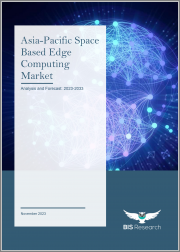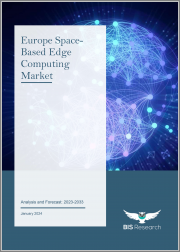
|
시장보고서
상품코드
1379168
아시아태평양의 우주 기반 엣지 컴퓨팅 시장(2023-2033년)Asia-Pacific Space Based Edge Computing Market - Analysis and Forecast, 2023-2033 |
||||||
아시아태평양의 우주 기반 엣지 컴퓨팅 시장 규모는 2022년 2,010만 달러에서 예측 기간 동안 22.74%의 CAGR을 나타내고, 2033년에는 1억 8,180만 달러 규모로 성장할 것으로 예상됩니다.
신기술의 발전과 군수산업 수요 증가가 이 시장의 성장을 주도하고 있습니다.
1990년대에 아카마이의 컨텐츠 전송 네트워크(CDN)가 도입되면서 엣지 컴퓨팅이 탄생했습니다. 이후 엣지 컴퓨팅 시장은 지속적으로 성장해 왔으며, 앞으로도 계속 성장할 것으로 예상됩니다. 우주 공간으로 이동하는 데이터센터에 대한 수요와 우주 공간에서의 지연 시간 단축에 대한 요구가 증가하면서 엣지 컴퓨팅의 한 유형인 우주 기반 엣지 컴퓨팅의 인기가 높아지고 있습니다.
현재 많은 우주 기관과 민간 기업들은 저궤도(LEO) 위성의 별자리 개발을 우선순위로 삼고 있으며, 이는 우주 기반 엣지 컴퓨팅 시장을 견인할 것으로 보입니다. 비용 효율적인 엣지 컴퓨팅 구성 요소의 개발도 시장을 촉진하는 요인 중 하나입니다.
아시아태평양의 우주 기반 엣지 컴퓨팅(Space-based Edge Computing) 시장을 조사했으며, 시장 개요, 시장 성장에 영향을 미치는 각종 영향요인 분석, 규제 환경, 시장 규모 추이 및 예측, 각 부문별/지역별/주요 국가별 상세 분석, 경쟁 구도, 주요 기업 분석 등의 정보를 전해드립니다.
| 주요 시장 통계 | |
|---|---|
| 예측 기간 | 2023-2033년 |
| 2023년 평가 | 2,340만 달러 |
| 2033년 전망 | 1억 8,180만 달러 |
| CAGR | 22.74% |
시장 구분 :
세분화 1: 최종 사용자별
- 상업
- 방어
- 민간 정부
세분화 2 : 국가별
- 중국
- 인도
- 일본
- 기타 아시아태평양
목차
제1장 시장
- 업계 전망
- 세계의 우주 기반 엣지 컴퓨팅 시장 : 개요
- 현재 및 새로운 기술 동향
- 엣지 기반 지구 관측 최적화
- 신흥 소형 위성 콘스테레이션(0-600Kg) : 우주 기반 엣지 컴퓨팅 솔루션의 성장 기회
- 진행중인 프로젝트와 향후 프로젝트
- 가격 분석 : 지상파, 클라우드 컴퓨팅, 엣지 컴퓨팅
- 스타트업과 투자 시나리오
- 밸류체인 분석
제2장 아시아태평양
- 세계의 우주 기반 엣지 컴퓨팅 시장(지역별)
- 아시아태평양
- 시장
- 용도
- 아시아태평양(국가별)
제3장 시장 : 경쟁 벤치마킹 및 기업 개요
- 경쟁 벤치마킹
- AICRAFT
- Spiral Blue
- SkyServe
- 기업 개요
- 경영전략
- 애널리스트의 견해
제4장 조사 방법
LSH 23.11.24“The Asia-Pacific Space Based Edge Computing Market Expected to Reach $181.8 Million by 2033.”
| KEY MARKET STATISTICS | |
|---|---|
| Forecast Period | 2023 - 2033 |
| 2023 Evaluation | $23.4 Million |
| 2033 Forecast | $181.8 Million |
| CAGR | 22.74% |
Introduction to Asia Pacific (APAC) Space-Based Edge Computing Market
The APAC Space-Based Edged Computing Market is expected to grow at a CAGR of 22.74% from $20.1 million in 2022 to $181.8 million by 2033 in the forecasted period of 2023-2033. The two primary sectors of the APAC space-based edge computing market are end users and component makers. The hardware and software utilized in space-based edge computing systems are developed and provided by component manufacturers. Organizations that collect and analyze data using space-based edge computing systems are known as end users. In the upcoming years, the APAC space-based edge computing market is anticipated to experience significant expansion. The market is being driven by new technology development and the military industry's increasing need.
Market Introduction
With the introduction of Akamai's content delivery network (CDN) in the 1990s, edge computing came into being. The plan was to physically relocate nodes in order to provide stored media, such as images and videos, closer to the user. The first desktop computers were developed in the late 1970s, during which time major tech companies such as IBM, Intel, Microsoft, and Apple started to appear. This was made possible by the advancement of microprocessors and other micro-tech. The market for edge computing has expanded since then and is expected to do so in the future. The increasing need for moving data centers in space and for latency reduction in space has led to a rise in popularity for one aspect of edge computing: space-based edge computing.
At the moment, low Earth orbit (LEO) satellite constellation development is a major global priority for numerous space agencies and commercial enterprises. The market for space-based edge computing would be driven by this. The development of cost-effective edge computing components through increased research and development efforts is another driver fueling the market for space-based edge computing.
Market Segmentation:
Segmentation 1: by End User
- Commercial
- Defense
- Civil Government
Segmentation 2: by Country
- China
- India
- Japan
- Rest-of-Asia-Pacific
How can this report add value to an organization?
Product/Innovation Strategy: The product segment helps the reader understand the different types of space-based edge computing markets available for deployment in the industries for space platforms and their potential in apac region. Moreover, the study provides the reader with a detailed understanding of the different space-based edge computing market by application (commercial, defense, and civil government).
Growth/Marketing Strategy: The APAC space-based edge computing market has seen major development by start-up players operating in the market, such as business expansion activities, contracts, mergers, partnerships, collaborations, and joint ventures. The favored strategy for the companies has been contracted to strengthen their position in the APAC space-based edge computing market.
Competitive Strategy: Key players in the APAC space-based edge computing market analyzed and profiled in the study involve space-based edge computing services and space-based edge computing product providers. Moreover, a detailed competitive benchmarking of the players operating in the APAC space-based edge computing market has been done to help the reader understand how players stack against each other, presenting a clear market landscape. Additionally, comprehensive competitive strategies such as contracts, partnerships, agreements, acquisitions, and collaborations will aid the reader in understanding the untapped revenue pockets in the market.
Key Market Players and Competition Synopsis
The companies that are profiled have been selected based on inputs gathered from primary experts and analysing company coverage, product portfolio, and market penetration.
Some of the prominent names established in this market are:
|
|
Table of Contents
1 Markets
- 1.1 Industry Outlook
- 1.1.1 Global Space-Based Edge Computing Market: Overview
- 1.1.2 Current and Emerging Technological Trends
- 1.1.2.1 Edge Computing With 5G
- 1.1.2.2 In-Orbit Data Centers
- 1.1.2.3 Edge Computing for Constellation Applications
- 1.1.2.4 Interplanetary Edge Computing
- 1.1.3 Edge-Based Earth Observation Optimization
- 1.1.4 Emerging Small Satellite Constellations (0-600Kg): A Growth Opportunity for Space-Based Edge Computing Solutions, 2023-2033
- 1.1.5 Ongoing and Upcoming Projects
- 1.1.5.1 ISS-HPE Spaceborne Computer
- 1.1.5.2 Space-Based Data Centers
- 1.1.6 Pricing Analysis: Terrestrial vs. Cloud Computing vs. Edge Computing
- 1.1.7 Startups and Investment Scenarios
- 1.2 Value Chain Analysis
2 Asia-Pacific
- 2.1 Global Space-Based Edge Computing Market (by Region)
- 2.2 Asia-Pacific
- 2.2.1 Market
- 2.2.1.1 Key Manufacturers and Service Providers in Asia-Pacific
- 2.2.1.2 Business Drivers
- 2.2.1.3 Business Challenges
- 2.2.2 Application
- 2.2.2.1 Asia-Pacific Space-Based Edge Computing Market (by End User)
- 2.2.3 Asia-Pacific (by Country)
- 2.2.3.1 China
- 2.2.3.1.1 Application
- 2.2.3.1.1.1 China Space-Based Edge Computing Market (by End User)
- 2.2.3.1.1 Application
- 2.2.3.2 Japan
- 2.2.3.2.1 Market
- 2.2.3.2.1.1 Key Manufacturers and Service Providers in Japan
- 2.2.3.2.2 Application
- 2.2.3.2.2.1 Japan Space-Based Edge Computing Market (by End User)
- 2.2.3.2.1 Market
- 2.2.3.3 India
- 2.2.3.3.1 Market
- 2.2.3.3.1.1 Key Manufacturers and Service Providers in India
- 2.2.3.3.2 Application
- 2.2.3.3.2.1 India Space-Based Edge Computing Market (by End User)
- 2.2.3.3.1 Market
- 2.2.3.4 Rest-of-Asia-Pacific
- 2.2.3.4.1 Market
- 2.2.3.4.1.1 Key Manufacturers and Service Providers in Rest-of-Asia-Pacific
- 2.2.3.4.2 Application
- 2.2.3.4.2.1 Rest-of-Asia-Pacific Space-Based Edge Computing Service Market (by End User)
- 2.2.3.4.1 Market
- 2.2.3.1 China
- 2.2.1 Market
3 Markets - Competitive Benchmarking & Company Profiles
- 3.1 Competitive Benchmarking
- 3.2 AICRAFT
- 3.2.1 Company Overview
- 3.2.1.1 Role of AICRAFT in Asia-Pacific Space-Based Edge Computing Market
- 3.2.1.2 Product Portfolio
- 3.2.2 Business Strategies
- 3.2.2.1 New Product Launch and Merger and Acquisition
- 3.2.3 Analyst View
- 3.2.1 Company Overview
- 3.3 Spiral Blue
- 3.3.1 Company Overview
- 3.3.1.1 Role of Spiral Blue in Asia-Pacific Space-Based Edge Computing Market
- 3.3.1.2 Product Portfolio
- 3.3.2 Corporate Strategies
- 3.3.2.1 Partnerships, Collaborations, Agreements, and Contracts
- 3.3.3 Analyst View
- 3.3.1 Company Overview
- 3.4 SkyServe
- 3.4.1 Company Overview
- 3.4.1.1 Role of SkyServe in Asia-Pacific Space-Based Edge Computing Market
- 3.4.1.2 Service Portfolio
- 3.4.2 Corporate Strategies
- 3.4.2.1 Partnerships, Collaborations, Agreements, and Contracts
- 3.4.3 Analyst View
- 3.4.1 Company Overview
4 Research Methodology
- 4.1 Factors for Data Prediction and Modeling












